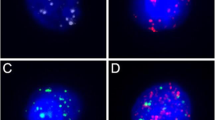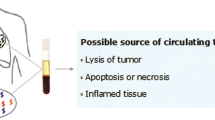Abstract
The aim of this study was to assess the prognostic value of EpCAM/MUC1 mRNA-positive circulating tumor cells (CTCs) in patients with non-small cell lung cancer (NSCLC). The presence of EpCAM/MUC1 mRNA-positive CTCs was evaluated in 74 NSCLC patients before the initiation of any therapy, from which 61 patients with surgical resection of tumor were also evaluable for EpCAM/MUC1 mRNA-positive CTC analysis after surgery, by quantitative real-time PCR assay. Sixty patients with benign lung disease (BLD) entered this study as controls. The results showed that blood levels of EpCAM and MUC1 mRNA in NSCLC patients before and after surgery were significantly higher than those in BLD patients (P = 0.001 and P = 0.015, respectively, for EpCAM; P = 0.003 and P = 0.026, respectively, for MUC1), and the levels of the two gene mRNA in NSCLC patients significantly decreased after surgery (P = 0.025 and P = 0.033, respectively). Disease recurrence significantly increased in NSCLC patients with EpCAM/MUC1 mRNA-positive CTC preoperation and postoperation (P = 0.004 and P = 0.001, respectively). Disease-free survival and overall survival significantly reduced in patients with EpCAM/MUC1 mRNA-positive CTC preoperation and postoperation (P = 0.012 and P = 0.002, respectively, for preoperation; both P < 0.001 for postoperation). Multivariate analysis demonstrated that the presence of EpCAM/MUC1 mRNA-positive CTCs before and after surgery was an independent factor associated with disease recurrence. In conclusion, the detection of EpCAM/MUC1 mRNA-positive CTCs in the blood before and after surgery is useful for predicting a poor prognosis in NSCLC patients who undergo curative surgery.



Similar content being viewed by others
References
Brundage MD, Devies D, Mackillop WJ. Prognostic factors in non-small cell lung cancer. Chest. 2002;122:1037–57.
Asamura H, Goya T, Koshiishi Y, et al. A Japanese Lung Cancer Registry study: prognosis of 13,010 resected lung cancer. J Thorac Oncol. 2008;3:46–52.
Parkin DM. Global cancer statistics in the year 2000. Lancet Oncol. 2001;2:533–43.
Pantel K, Alix-Panabieres C, Riethdorf S. Cancer micrometastases. Nat Rev Clin Oncol. 2009;6:339–51.
Pantel K, Brakenhoff RH, Brandt B. Detection, clinical relevance and specific biological properties of disseminating tumour cells. Nat Rev Cancer. 2008;8:329–40.
Lu J, Fan T, Zhao Q, et al. Isolation of circulating epithelial and tumor progenitor cells with an invasive phenotype from breast cancer patients. Int J Cancer. 2010;126:669–83.
Ross JS, Slodkowska EA. Circulating and disseminated tumour cells in the management of breast cancer. Am J Clin Pathol. 2009;132:237–45.
Ring AE, Zabaglo L, Ormerod MG, Smith IE, Dowsett M. Detection of circulating epithelial cells in the blood of patients with breast cancer: comparison of three techniques. Br J Cancer. 2005;92:906–12.
Xenidis N, Ignatiadis M, Apostolaki S, et al. Cytokeratin-19 mRNA-positive circulating tumor cells after adjuvant chemotherapy in patients with early breast cancer. J Clin Oncol. 2009;27:2177–84.
Alix-Panabieres C, Sabine Riethdorf S, Pantel K. Circulating tumor cells and bone marrow micrometastasis. Cin Caner Res. 2008;14:5013–21.
Baeuerle PA, Gires O. EpCAM (CD326) finding its role in cancer. Br J Cancer. 2007;96:417–23.
Went PTH, Lugli A, Meier S, et al. Frequent EpCAM protein expression in human carcinomas. Hum Pathol. 2004;35:122–8.
Went P, Dirnhofer S, Schöpf D, et al. Expression and prognostic significance of EpCAM. J Cancer Mol. 2008;3:169–74.
Rao CG, Chianese D, Doyle GV, et al. Expression of epithelial cell adhesion molecule in carcinoma cells present in blood and primary and metastatic tumors. Int J Oncol. 2005;27:49–57.
Kufe DW. Mucins in cancer: function, prognosis and therapy. Nat Rev Cancer. 2009;9:874–85.
Hollingsworth MA, Swanson BJ. Mucins in cancer: protection and control of the cell surface. Nat Rev Cancer. 2004;4:45–60.
Nagai S, Takenaka K, Sonobe M, Eiji O, Hiromi W, Fumihiro T. A novel classification of MUC1 expression is correlated with tumor differentiation and postoperative prognosis in non-small cell lung cancer. J Thorac Oncol. 2006;1:46–51.
Tsutsumida H, Goto M, Kitajima S, Kubota I, Hirotsu Y, Yonezawa S. Combined status of MUC1 mucin and surfactant apoprotein A expression can predict the outcome of patients with small-size lung adenocarcinoma. Histopathology. 2004;44:147–55.
Ohgami A, Tsuda T, Osak T, et al. MUC1 mucin mRNA expression in stage I lung adenocarcinoma and its association with early recurrence. Ann Thorac Surg. 1999;67:810–4.
Livak KJ, Schnittgen TD. Analysis of relative gene expression data using real-time quantitative PCR and the 2−ΔΔCt method. Methods. 2001;25:402–8.
Sergeant G, Penninckx F, Topal B. Quantitative RT-PCR detection of colorectal tumor cells in peripheral blood—a systematic review. J Surg Res. 2008;150:144–52.
Xenidis N, Perraki M, Kafousi M, et al. Predictive and prognostic value of peripheral blood cytokeratin-19 mRNA-positive cells detected by real-time polymerase chain reaction in node-negative breast cancer patients. J Clin Oncol. 2006;24:3756–62.
Liu Z, Jiang M, Zhao J, Ju H. Circulating tumor cells in perioperative esophageal cancer patients: quantitative assay system and potential clinical utility. Clin Cancer Res. 2007;13:2992–7.
de Albuquerque A, Kubisch L, Stolzel U, et al. Prognostic and predictive value of circulating tumor cell analysis in colorectal cancer patients. J Transl Med. 2012;10:222–8.
Tanaka F, Yoneda K, Kondo N, et al. Circulating tumor cell as a diagnostic marker in primary lung cancer. Clin Cancer Res. 2009;15:6980–6.
Yamashita J, Matsuo A, Kurusu Y, Saiahoji T, Hayashi N, Ogawa M. Preoperative evidence of circulating tumor cells by means of reverse transcriptase-polymerase chain reaction for carcinoembryonic antigen messenger RNA is a independent predictor of survival in non-small cell lung cancer: a prospective study. J Thorac Cardiovasc Surg. 2002;124:299–305.
Yie S-M, Lou B, Ye S-R, et al. Clinical significance of detecting survivin-expressing circulating cancer cell in patients with non-small cell lung cancer. Lung Cancer. 2009;63:284–90.
Yoon SO, Kim YT, Jung KC, Jeon YK, Kim BH, Kim CW. TTF-1 mRNA-positive circulating tumor cells in the peripheral blood predict poor prognosis in surgically resected non-small cell lung cancer patients. Lung Cancer. 2011;71:209–16.
Fidler IL. The pathogenesis of cancer metastasis: the “seed and soil” hypothesis revisited. Nat Rev Cancer. 2003;3:453–8.
O'Sullivan GC, Collins JK, Kelly J, Morgan J, Madden M, Shanahan F. Micrometastases: marker of metastatic potential or evidence or residual disease? Gut. 1997;40:512–5.
Fehm T, Becker S, Becker-Pergola G, et al. Presence of apoptotic and nonapotptotic disseminated tumor cells reflects the response to neoadjuvant systemic therapy in breast cancer. Breast Cancer Res. 2006;8:R60.
Zieglschmid V, Hollmann C, Bocher O. Detection of disseminated tumor cells in peripheral blood. Crit Rev Clin Lab Sci. 2005;42:155–96.
Conflicts of interest
None
Author information
Authors and Affiliations
Corresponding author
Rights and permissions
About this article
Cite this article
Zhu, WF., Li, J., Yu, LC. et al. Prognostic value of EpCAM/MUC1 mRNA-positive cells in non-small cell lung cancer patients. Tumor Biol. 35, 1211–1219 (2014). https://doi.org/10.1007/s13277-013-1162-8
Received:
Accepted:
Published:
Issue Date:
DOI: https://doi.org/10.1007/s13277-013-1162-8




